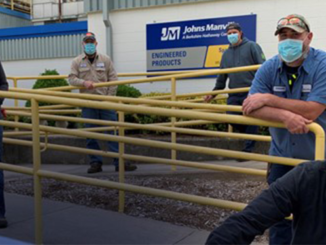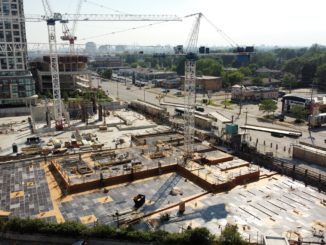
Labour, materials, and inflation remain top concerns, but infrastructure projects and federal support are on the way
By / par Robin Brunet
In some ways, 2023 for the Canadian construction sector is shaping up to be a repeat of 2022 in that it is experiencing an embarrassment of riches. The riches are a wide array of major projects that, for the main, commenced last year. The embarrassment—or challenge—is the ongoing question of whether there will be enough manpower to handle all the work.
Some circumstances make the construction landscape different from 2022. For example, in some cases skyrocketing materials prices are starting to stabilize, and the hope is they will begin to move downward as the year progresses. Also, rampant inflation is, unlike last year, beginning to take its toll in the form of a cooling off of the once white-hot residential market.
But above everything else, labour is the dominant concern of the industry’s advocacy leaders. Driving them is Ottawa’s plan to repair, maintain, and retrofit infrastructure while also building for future climate resilience—at a time when the construction industry is struggling to fill over 81,000 jobs nationwide.
While last year’s announcement from the federal government that Canada would welcome up to 500,000 new immigrants annually by 2025 is helpful, it’s only a start as far as the Canadian Construction Association (CCA) is concerned. It is calling for Ottawa to modernize its immigration policy and point system to better recognize labourers and those with relevant skills; work with the provinces to ensure skills matching is properly funded and supported; and update the Temporary Foreign Worker program.
CCA president Mary Van Buren points out that older workers reaching retirement will contribute to the problem if steps aren’t taken to rebuild Canada’s workforce now.
“The current federal immigration point system does not favour the trades,” she says. “Many newcomers cannot even find work in their field of expertise. We need to put their skills and experience to work and expedite the recognition of their training and credentials.”
Ian Cunningham president, Council of Ontario Construction Associations, (COCA), says of home-grown recruits, “It will be extremely difficult to train them quickly enough to meet capacity.” Therefore, Cunningham thinks the rollout of Ottawa’s infrastructure upgrades—as well as many other projects—may happen more slowly than desired.
Still, Ontario is a good example of immense projects underway that are proceeding smoothly, and Cunningham cites the Ontario Line and the Gordie Howe International Bridge as two of dozens of examples of major projects that dominated 2022 and will continue in 2023. The former is a 15.6-kilometre subway line that will make it faster and easier to travel within Toronto and beyond. The latter, which has been under construction since 2019, will connect Windsor to Detroit; the towers of the bridge were recently completed, and once the entire $5.7 billion structure is completed in 2024 it will be the longest cable-stayed bridge in North America at 0.53 miles. “The point is, every section of our province is busy with big projects,” Cunningham says.
The same holds true for other provinces. “We have two major electric car battery plants going into Ontario and one in Quebec,” says Sean Strickland, executive director, Canada’s Building Trades Union (CBTU). “In Saskatchewan there is a major potash project ramping up. In Alberta are a host of upcoming carbon sequestering projects, and in B.C. workers are occupied with lots of road building and a massive extension to the SkyTrain line.”
In fact, SkyTrain is undergoing two massive extensions, one being a 5.7 kilometer extension of the Millennium Line (with six underground stations) scheduled to open in 2026. The Surrey Langley SkyTrain project will extend the Expo Line 16 kilometers to Langley City.
The Alberta activity mentioned by Strickland stems from Emissions Reduction Alberta committing $40 million from the province’s Technology Innovation and Emissions Reduction fund to 11 projects worth $194 million. If successful, these projects could lead to over $20 billion in capital expenditures and create thousands of jobs.
As for Saskatchewan and potash, workers at the Jansen potash mine in November completed the excavation and lining of the 1,000 meter deep shafts, the largest of their kind in the province. Owner BHP is seeking to accelerate the $5.7 billion project with the aim to start potash extraction in 2026.
Strickland is united with Van Buren and Cunningham in calling for a rebuilding of Canada’s workforce. “We currently bring in 100,000 new apprentices yearly, but we need to do better,” he says. “We also need to support apprentices by putting minimum requirements for them into work contracts.”
But Strickland is cautiously optimistic of the strides made so far. “In working on express entry immigration with Ottawa, we made headway with heavy equipment operators in 2022,” he says. “Also, B.C. has a best in class program that would help nurture a new generation of Canadian construction workers. It could and should be replicated in other provinces.”
Strickland is referring to BC Infrastructure Benefits (BCIB), a Crown corporation accountable for implementing the Community Benefits Agreement (CBA) on select public infrastructure projects. BCIB’s purpose includes mobilizing and growing a safe, diverse, and skilled workforce. It is the employer for all employees on CBA projects and ensures priority hiring is given to equally qualified local residents, Indigenous people, and other underrepresented groups (it is also responsible for training, capacity building and worker support).
Despite all the concerns, construction association leaders are fairly optimistic that their industry can meet the needs of both government and private developers. “There have always been and always will be challenges in our industry,” Cunningham says. “But at the end of the day we’re a can-do bunch of people. I’m always amazed at what can be done and what gets done.” ▪



